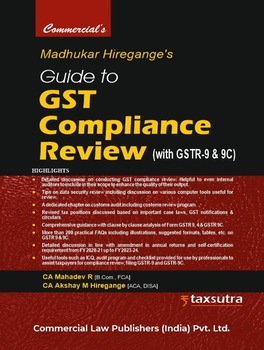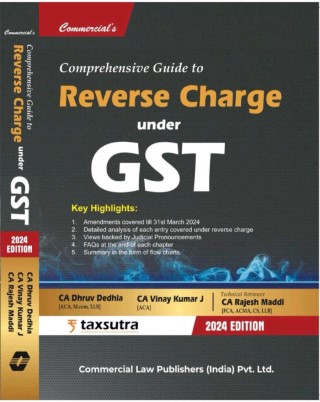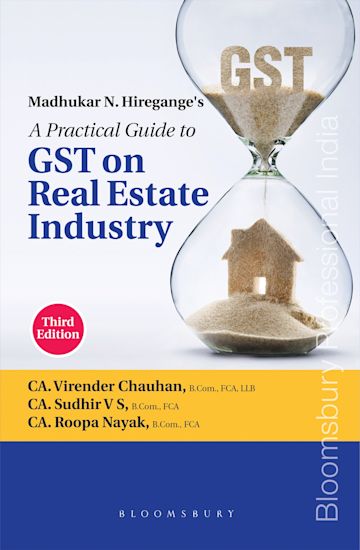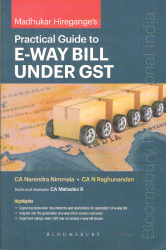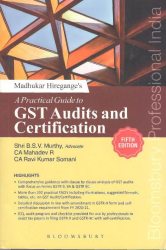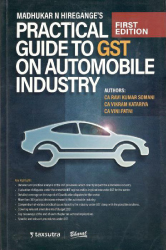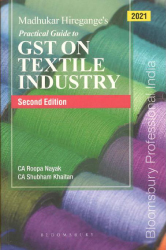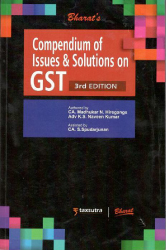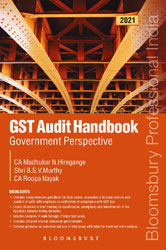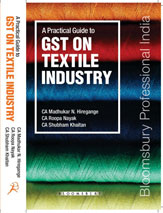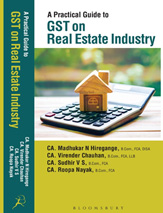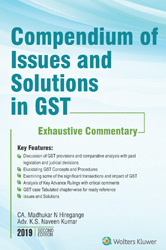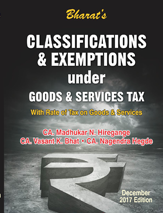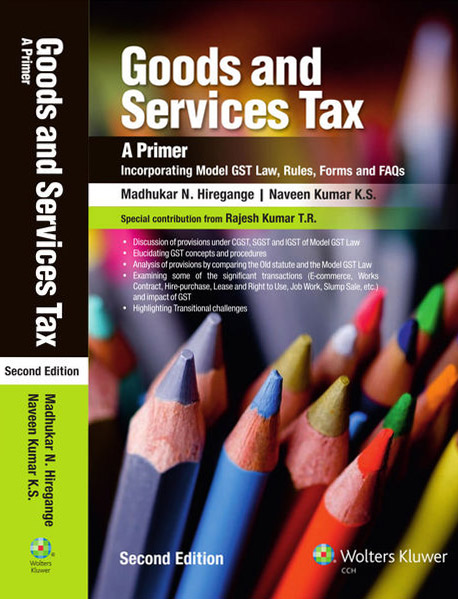
Publications
Madhukar Hiregange's Guide to GST on Textile Industries (Edition 2025)
-
In-Depth Practical Analysis –A detailed examination of GST provisions specific to the textile industry, supported by relevant landmark judgments.
-
Common Issues & Solutions – Addresses real-world challenges faced by industry players, including inverted duty structures, compliance burdens, and varying tax rates across the textile value chain, while providing actionable solutions.
-
Impact of GST on the Value Chain – Examines GST’s implications on different aspects of the textile supply chain, from raw material procurement to finished product distribution, and its effect on cash flow, input tax credit utilization, and compliance requirements.
- Strategic Tax Planning– Offers practical insights into tax-saving opportunities, dispute mitigation strategies, and compliance best practices tailored to textile businesses.
Guide to GST Compliance Review (with GSTR-9 & 9C) (2024 Edition)
- Detailed discussion on conducting GST compliance review. Helpful to even internal auditors to include in their scope to enhance the quality of their output.
- Tips on data security review including discussion on various computer tools useful for. review.
- Adedicated chapter on customs audit including customs review program.
- Revised tax positions discussed based on important case laws, GST notifications & circulars.
- Comprehensive guidance with clause by clause analysis of Form GSTR9, 4 & GSTR9C.
- More than 200 practical FAQ's including illustrations, suggested formats, tables, etc. on GSTR9&9C.
- Detailed discussion in line with amendment in annual returns and self-certification requirement from FY2020-21 up to FY 2023-24.
- Useful tools such as ICQ, audit program and checklist provided for use by professionals to assist taxpayers for compliance redow, filing GSTR-9 and GSTR-9C.
Commercial's, Comprehensive Guide to Reverse Charge Under GST
Highlights of the book:
- Amendments covered till 31st March 2024.
- Detailed analysis of each entry covered under reverse charge.
- Views backed by Judicial Pronouncements.
- FAQs at the end of each chapter.
- Summary in the form of flow charts.
Goods and Service Tax Sem V (Bangalore Univ)
- Prerpared as per new NEP syllabus for the 5th semester of B.com and 6th Semester BBA and all other universities of Karnataka.
- Practical illustrations for easy understanding of the students
- Place of supply concept recently
Practical Guide to GST on Automobile Industry (2nd Edition)
- Detailed and practical analysis of GST provisions which directly impact the automobile industry
- Evaluation of disputes under the erstwhile IDT regime and its implications under GST for this sector
- Exhaustive commentary on Classification and Valuation disputes for this industry
- Compendium of various practical issues faced by the industry under GST along with possible solutions
- More than 350 judicial decisions relevant to the automobile industry
- Updates of 50th GST Council meeting covered in this edition
- Specific and relevant procedures and compliances under GST
GST Judicial Precedents
- Comprehensive coverage of case laws under GST.
- Analysis of pending issues under GST.
- Possible areas of disputes under GST.
- Coverage of case laws under Pre-GST laws.
- Coverage of foreign GST/VAT laws.
- User-friendly format.
Practical guide to GST On Real Estate
- Detailed and practical analysis of the GST provisions with case laws pertaining to the real estate industry.
- Covering all possible dispute areas along with their resolutions.
- Coverage of analysis of the tax planning aspect.
- Extensive FAQs for removal of doubts.
- Blank as well as filled forms for better understanding.
- Detailed discussion on the role of professionals on how they can help in various GST matters.
- Visit http://bit.ly/GSTrealestate for important information.
Practical Guide to E-WAY BILL UNDER GST
- History of e- way bills including the need for generating of e- way bill.
- Capturing state-wise requirements and exemptions for generation of e-way bill.
- Decoding the e-way bill dashboard.
- Insights into the generation of e-way bill in various scenarios including examples.
- Interplay of e-way bill with e-invoicing and Vahan system.
- Important rulings under GST law in various e-way bill issues.
GST Audits and Certification Fifth Edition
Key Features :
-
Includes practical tables giving step by step approach with internal control questionaries, checklists, templates , good accounting practices review program and reconciliation statements for:
- Filing annual return
- Audit certification
- Detailed analysis of reporting comments , remarks and qualifications in Part B of GSTR 9C along with exhaustive list of sample observations, remarks to be reported which would be relevant till FY 2019-20.
- Detailed discussion on various other key reconciliations including ITC, outward supplies , etc.
- Extensive list of common errors to be avoided in GST while doing preparation for audit.
- Coverage of key reconciliations viz., GSTR 2A to 3B , GSTR1 to 3B etc.,
- Extensive discussion on professional approach to GST audit using the internal control questionaries and sample audit program for enabling taxpayers in filing GSTR 9C form.
- Insights on key year-end activities & relationship between GSTR1 , GSTR 3B & GSTR 9.
- Covering important tools/techniques for optimization of tax , ITC, year-end actions, and some decisions in Favour of taxpayers to avoid future disputes and adding value.
PRACTICAL GUIDE TO GST ON AUTOMOBILE INDUSTRY
Key Highlights:
- Detailed and practical analysis of the GST provisions which directly impact the automobile industry.
- Evaluation of dispute under the erstwhile IDT regime and its implications under GST for the sector.
- Detailed coverage on the aspect of Classification disputes for the sector.
- More than 300 judicial decisions relevant to the automobile industry.
- Compendium of various practical issues faced by the industry under GST along with the possible solutions.
- Covering relevant amendments of Budget 2021.
- Key takeaways at the end of each chapter on sectoral implications.
- Specific and relevant procedures under GST.
GST ON TEXTILE INDUSTRY Second Edition
Key Features:
- Detailed and practical analysis of the GST provisions with relevant land mark case laws and checklist pertaining to the textile industry.
- Covering possible dispute areas along with their resolutions.
- Detailed analysis of the tax planning aspect.
- Covering FAQs for removal of doubts.
- Blank as well as filled forms for better understanding and ease of compliance.
- Detailed discussion on the role of professionals on how they can help in various GST matters.
- Covering relevant amendments of Budget 2021.
Compendium Issues and Solution on GST 3rd EDITION
The third edition is quite comprehensive and contains discussion on many basic and contentious issues and solutions. The current issues relating to each topic have been analysed systematically. Wherever needed, reference to judgements of the past regime have been made. Many final judgments on constitutional validity and vires of the provisions/rules etc. have been discussed at the appropriate places. That apart, at the end of each chapter significant judgements have been summarised for ready reference. Relevant circulars have also been mentioned to give the readers a perspective of department's stand on certain contentious issues.
GST Audit Handbook - Government Perspective
This book supplements and expands the concepts, guidelines, principles, details and working methods in Perspective the GST Audit Manual published by the government wherever it was felt that there is a need.
This book is divided into 12 chapters
ABOUT THE BOOK
- Includes drafts of letters to tax payers.
- Contains detailed internal evaluation questionnaire.
- Samples of walk through, audit plan, tables for trend and ratio analysis.
- Details of verification work in the office before audit and during audit.
- Covers latest case laws relating to audit and GST issues.
- Contains guidance on 'How to read financial reports?'
- Discussion of relevant Accounting Standards
GST on Healthcare
The book on Practical Guide to GST on Healthcare and Pharmaceutical Sectors encompasses a comprehensive commentary on various GST implications for the Sector. The primary objective of this book is to provide comprehensive insights on GST implications on specific aspects of the Sector. The book is covered in three parts
- Part A covers Healthcare service sector and the allied services which are provided under this Sector. Discussions on ITC provides an opportunity for the Sector to identify avenues to optimise the benefit of input tax credit and reduce the cost of operations.
- Part B covers the Pharmaceutical sector. It is a known fact that one of the most complicated area in the context of indirect tax for this sector, is the issue of classification.
- Part C provides an overview on the provisions of the GST law, to the extent the same are applicable for the Sector at large.
GST on Textile Industry
The book which is available online as well as all major book stalls provide a practical approach covering the following :
- Detailed and practical analysis of the GST provisions with case laws and checklists pertaining to the textile industry.
- Covering possible dispute areas along with their resolutions.
- Detailed analysis of the tax planning aspect.
- Covering FAQs for removal of doubts.
- Blank as well as filled forms for better understanding and ease of compliance.
- Detailed discussion on the role of professionals on how they can help in various GST matters.
GST on Real Estate Industry
Key Features: -
The purpose of this book is to enable the taxable person to understand the applicability and impact of GST provisions with respect to the Real Estate Industry. The comprehensive and in-depth practical knowledge of the four authors would help in implementation of the provisions in an easy manner.
This book is divided into eight parts as follows:
- Introduction and Overview
- GST impact analysis on real estate developers: Complex Developers, Joint Development, contractors and other income.
- Detailed operational law containing classification, registration, tax credits, documentation, payments etc.
- Detailed procedural law containing assessment, audit, advance ruling, appeals, penalties, demands etc.
- Tax planning avenues, GST and RERA, Transitional provisions
- Disputes and department actions, [focussing on possible dispute area & resolution].
- Role of Professionals from GST audit and tax planning perspective.
- Miscellaneous: 220+ FAQs and filled forms.
- Appendices containing FAQs released by CBIC.
Compendium of Issues and Solutions in GST
Key Features: -
- Discussion of GST provisions and comparative analysis with past legislation and judicial decisions
- Elucidating GST Concepts and Procedures
- Examining some of the significant transactions and impact of GST
- Analysis of Key Advance Rulings with critical comments
- GST case Tabulated chapter-wise for ready reference
- Issues and Solutions
GST Audits and Certification
The book has been written with a perspective to enable the taxpayers to ensure compliance with GST audits. It provides comprehensive guidance for conducting different types of GST audits. It includes provisions of key auditing and accounting standards relevant to GST and practical tables giving step by step approach with internal control questionaires, checklists, review program and reconciliation statement for filing annual return and audit certification in form GSTR-9C. Eight key reconciliation statements for ITC, outward supplies etc. have been provided for the use of tax payers.
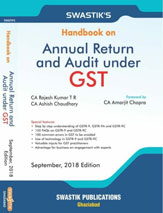
Annual Return (GSTR-9 and GSTR-9A) and Audit (GSTR-9C) under GST
The book is a ready reckoner on all important aspects of the Annual Return (GSTR-9 and GSTR-9A) and GST Audit (GSTR-9C) equally useful for the GST professionals and businesses. Step by step discussion on these forms in lucid language makes their understanding very clear. 150 FAQs on Annual Return and Audit clarifies the most of doubt which could arise with users. Avoidance of common errors highlighted in the book could ensure that the Annual Return and Annual Audit compliance are done immaculately. Last but not the least, the use of technology in preparation of the forms gives guidance as to manner in which entire process of forms preparation can be automated.
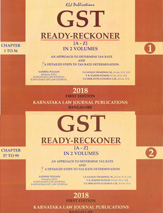
GST Ready Reckoner
This book is a reference material for the tax payers, tax practitioners, and tax administrators to identify the applicable rate of tax on the goods and services under GST. This book has four parts.
- Part I: Approach to determine tax rate
- Part II: Classification of goods and their rate of tax
- Part III: Classification of services and their rate of tax
- Part IV: Reference materials: notification & circulars extracts and FAQ’s

Compendium of Issues and Solutions in GST - with Exhaustive Commentary
This book on GST contains exhaustive commentary on the subject and contains discussion on issues and solutions. It is useful to tax payers and officers and is a good reference book for professionals. Recommendations on law, administration, procedures and policy have been made with a commitment to ensure simplicity, certainty, clarity and transparency in GST law by providing sufficient inputs to the law and policy makers. It also serves as a research material for students and avid readers. In sum, it contains all that one should know about GST as it stands now.
Classifications & Exemptions under GST
Though the GST is new form of taxation in India, many provisions of GST are taken from various existing taxation laws. Classification of goods and services has gained greater importance in GST on account of multiple rates. The book explains why classification is so important, various principles of classification, how to correctly classify the goods and services, what are the settled legal precedents on classification etc. The books also explains the various exemptions available und GST law, how to meet the conditions of exemptions and avail the benefits etc. Further, the book also contains the following Appendices incorporating the changes made till end of November 2017:
- Chapterwise rate and exemptions for goods
- GST rate as per Scheme of classification (SAC)
- GST rate vis a-vis erstwhile service categories
- GST exemptions - Goods
- GST exemptions - Service
Goods and Services Tax - A Primer
Introduction of Goods and Services Tax (GST) is perceived as the biggest tax reform of independent India. GST would subsume many indirect tax laws enacted by the Union and States. With the dynamic developments around GST, the present Government is keen to roll out GST from 1st April 2017. This Edition provides an insight into the concept of GST and its impact on trade and industry. It serves as a guide to tax payers and prepares them for smooth transition from present regime. The book extensively discusses the Model GST Law released by the Government and draft rules and business processes. Recommendations on law, administration, procedures and policy have been made with a commitment to ensure simplicity, certainty, clarity and transparency in GST law by providing sufficient inputs to the Law and policy makers.

Goods and Service Tax
This book on GST provides an insight into the concept of GST and its impact on trade and industry. It serves as a guide to tax payers and prepares them for smooth transition from present regime. It is a good reference book for professionals who either practice or intend to practice indirect taxes. The industry would get an idea of the way GST would unfold and for specific transactions (works contract, hire purchase, etc), the possible alternatives.
Recommendations on law, administration, procedures and policy have been made with a commitment to ensure simplicity, certainty, clarity and transparency in GST law by providing sufficient inputs to the law and policy makers. It also serves as a research material for students and avoid readers. In sum, it contains all that one should know about GST as it stands now.

Student’s Handbook on Indirect Taxes
The Student's hand Book on Indirect Taxation for IPCC covers all the aspects dealt in the study material of the Institute of Chartered Accountants of India.
The Student's hand Book on Indirect Taxation for IPCC seeks to arouse the curiosity in the subject and enable the student to get conceptual clarity. The examples would also be practical in nature, which would bring in the vital component of applicability of learning in real life situations. Wherever possible the examples have been based on the decisions of the courts. The Student's Hand Book also provides a few tips in the appendix of each chapter for the student to do his/ her work in respective offices where exposed to IDT. While the main objective of the book is to prepare for and excel in this subject, the basic understanding of the tax laws in this regard is also proposed to be in incidental gain.

Practical Guide to Service Tax
This book is an attempt to introduce the law and procedure of service tax as they stand today in simple way to make reading easy. All items in declared services, negative list and exemptions have been discussed in easily readable/understandable format. Practical issues which authors have come across have also been added as common issues with their views.
As service tax follws central excise and is increasingly becoming procedural in nature, an attempt to provide-how to do? In various segments have provided some answers. For the consultant, the checklist for ST-3, service tax review audit program, listing of classification with tips will be useful.
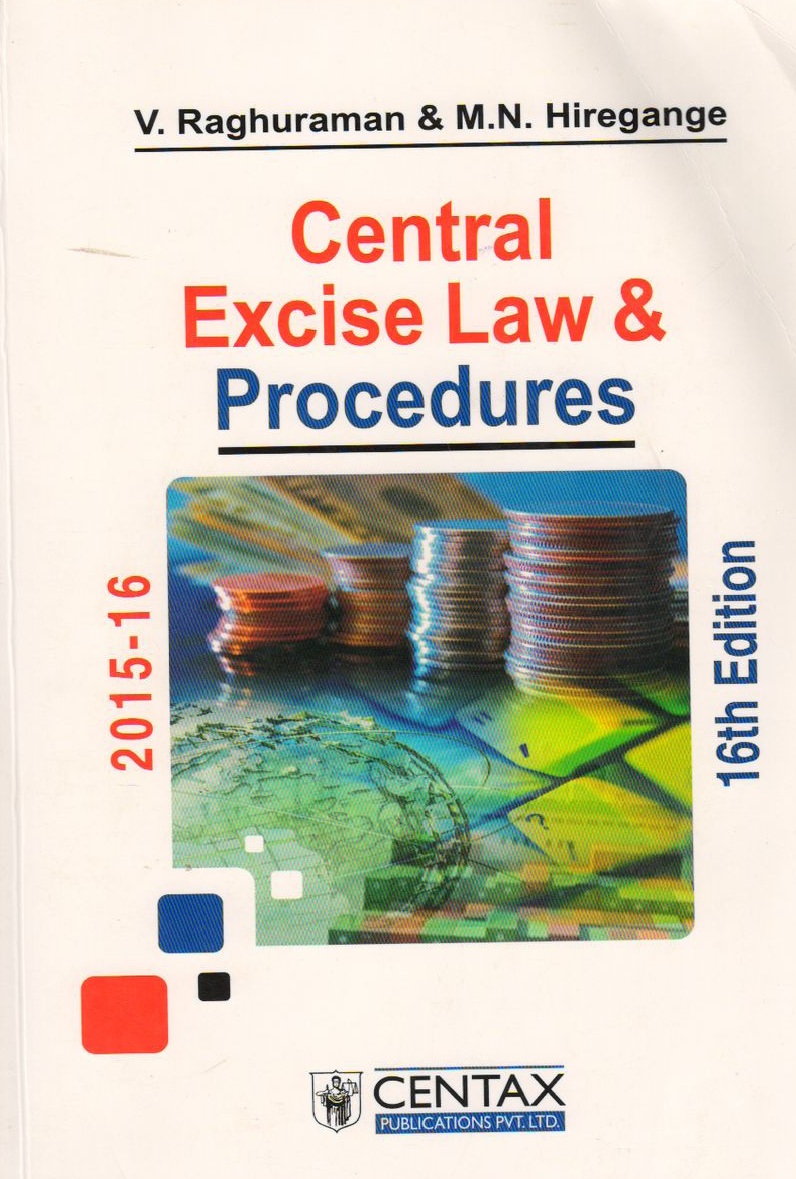
Central Excise Law & Procedures
The book is simple yet comprehensive book on excise written in layman's language having reference to the important case laws on the subject without getting into elaborate legal tangles. Special efforts have been put based on experience of authors and previous departmental clarifications to suggest appropriate procedures where there exist none to alleviate the problems of the assessee.
Every efforts has been made to incorporate all the important case laws to provide a one place reference all relevant case laws. At the same time, efforts have been made to give a complete step by step procedure with circular reference and authors? note so that the reader gets a full view of the said procedure at one place. Procedures have been recommended where there exist none keeping in mind the legal framework. Guidelines to fill formats have been provided. What we deem a special effort is the attempt to flow chart complicated provisions of law/procedure and present it in an easily understandable form.

Central Sales Tax
The book has been written covering important concepts, case laws and possible dispute areas along with resolution under Central Sales Tax Act. The movement of goods on stock transfer basis, subsequent sale, sale in course of import and export are a few of the important areas where tax planning and savings are possible. The student who wishes to understand sales tax could use this as a ready reference. This book contains practical tips for common issue faced by practitioners in this area as well. The probable impact of GST laws on concepts discussed is touched on in most chapters. The book is available in online version.

Central Excise Made Simple
The book gives a in depth view on the various terms such as manufacture, levy, liability etc., with the elaborate commentary of the authors. It also provides the updated Excise rules and with the relevant case laws for the particular terms such as input, input service, capital goods etc., For the better understanding of the book, Central Excise Act 1944 has also been provided.
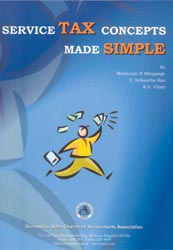
Service Tax Concepts Made Simple
This book contains an overview of service tax initially which would provide the reader with a bird eye view of service tax. Advices to go through the same proceedings onto the subsequent chapters. This book also contains some of the important procedures which would be useful to the assessee in complying to the legal provisions of the service tax.
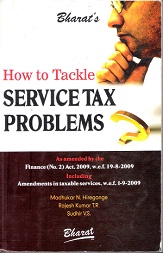
How to Tackle Service Tax Problems
The expanding coverage of many activities as taxable services from the view point that what is not liable under the erstwhile sales tax could possibly covered under service tax being implemented appears to to be flawed and is leading to a number of entries to be found to be non est in law.the purpose of this book is that service providers can understand the present legal framework within which they work by referring to the specific area of their concern.

Guide to VAT Audit and Value Added Tax in Karnataka
The book has been written by authors to address the complexities involved in the VAT Audit in Karnataka Value Added Tax. The detailed procedure as to how the audit should be done. Also, all the provision of law and their practical application has been discussed in lucid language for the professionals. The book is updated containing the provisions upto year 2009.
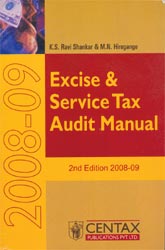
Excise & Service Tax Audit Manual
The book is not only a conventional book on auditing but also has approached the subject of excise audit and service tax audit from the legal standpoint apart from procedure and techniques of audit. A separate section of the book contains asset of appendices that gives a relevant abstract from statues, reference material and instructions issued by the CBEC, which have been reported in the journal ELT and STR. An effort has been made to bring as much relevant information and reference material as possible to reference to excise audit and service tax audit.

Karnataka Value Added Tax Law & Procedures
In this book the author has made an attempt to provide the discussion on Karnataka Value Added Tax law in a simple manner. The procedures most of them recommendatory haven suggested keeping in mind the objective of the law to safeguard the revenue at the same time to avoid unnecessary paperwork. Illustrations of the concepts of the methodology of VAT itself as well as the input credits.
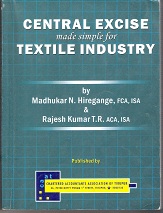
Central Excise Made Simple on Textile Industry
This book made an attempt to introduce the law and procedure of excise in the first chapter devoid of the sections/ Rules Circulars/ Trade Notices and analytical studies. For the interested an explanatory section has been included providing the main judicial decisions / definitions as may be required. The topics / subjects of interest to the industry has been elicited from many traders, manufacturers, exporters and the trade associations.
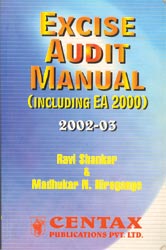
Excise Audit Manual (Including EA 2000)
The book is not only a conventional book on auditing but has approached the subject of excise audit from the legal standpoint apart from procedure and techniques of audit. A separate section of the book contains asset of appendices that gives a relevant abstract from statues, reference material and instructions issued by the CBEC, which have been reported in the journal ELT. An effort has been made to bring as much relevant information and reference material as possible to reference to excise audit.
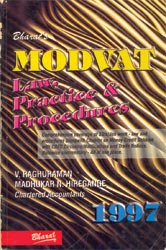
MODVAT Law, Practice & Procedures
It is indeed a book on MODVAT which put before the readers, whether professionals, industrialists or judges, not only the law in easy readable manner but also the entire amount of procedures with a practical tips on how to actually handle individual procedure on, MODVAT. Presentation of the commentary predominantly in table form which enhances utility and readability of the user. Presents currently applicable case laws in a gist in tabular form.


